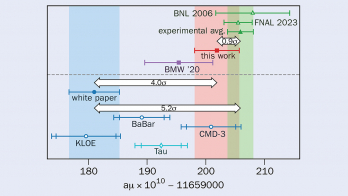by Lisa Randall, Allen Lane, Penguin Books. Hardback ISBN 0713996994, £25.
(In the US, HarperCollins, ISBN 0060531088, $27.95.)
They say you should never judge a book by its cover, which is advice worth considering if you’re thinking of buying Lisa Randall’s Warped Passages. The violent pink with the title scrawled graffiti-like across it (in the Penguin edition) makes the book jump off the shelf, screaming “I’m no ordinary popular-science book.” Don’t be put off. Randall does break the mould, but not by filling the book with graffiti. She delivers a bold journey from the origins of 20th-century science to the frontiers of today’s theoretical physics. It’s bold because, despite her protestations that the book is about physics and not personalities, it turns out to be a very personal journey in the company of one of the field’s most cited practitioners.

This is most true at the beginning, where Randall tells us a little about who she is and why she has devoted her life’s work to the science of extra dimensions. She begins with the words: “When I was a young girl, I loved the play and intellectual games in math problems or in books like Alice in Wonderland.” Thereafter, she affords us a glimpse of who she is through her choice of musical snippets at the beginning of each chapter, and the Alice-inspired story of Ike, Athena and Dieter, which unfolds throughout the book, one episode per chapter. The result is that the reader gets not only a competent review of a difficult subject, but also a feeling for what drives someone at the cutting edge of science.
I have to confess that I read the story of Ike, Athena and Dieter from cover to cover before embarking on the book proper, and having done so would recommend that course of action. Should physics cease to be a fruitful career, Randall could perhaps turn her hand to fiction. Coupled with the What to Remember and What’s New sections at the end of each chapter, the story gives a pretty good overview of what the book is about.
The personality that emerges as the book progresses is not the kind of physicist who would be lost for words at a party if asked what she does. As well as being, according to her publisher, the world’s most influential physicist thanks to the citations-index-topping paper she published with Raman Sundrum in 1999, Randall is also a woman with a life. She has broad interests, she is cultured and she climbs mountains in her spare time. In short, she’s the sort of role model science needs.
Clearly conscious of the “no equations” school of science communication, she tries early on to put the reader at ease by promising that the descriptions will never be too complicated. Inevitably she cannot hold this promise throughout, and there are places where even the most dedicated amateur scientists will be baffled, but that is more the nature of the subject than the author. If Niels Bohr thought that quantum mechanics was profoundly shocking, what would he have made of hidden dimensions? In places, Randall goes so far to try to make things easy that the tone verges on the patronizing, and in others, she hides difficult stuff in a “math notes” section at the end of the book. On balance, however, she has done a good job of making a difficult subject accessible.
Bohr is on record as saying to a young physicist, “We are all agreed that your theory is crazy. The question which divides us is whether it is crazy enough to have a chance of being correct.” Could the same be true of extra dimensions? If you do not already have an opinion, this book will certainly help you to make up your mind. Don’t let the cover, or the publisher’s hype, put you off.








